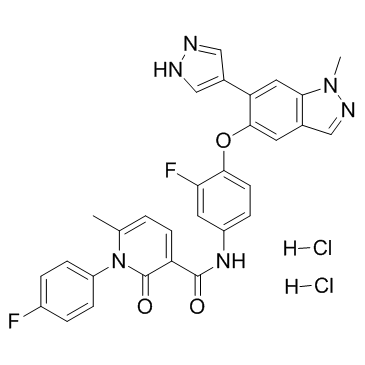Merestinib dihydrochloride |
| Catalog No.GC36585 |
Merestinib dihydrochloride (LY2801653 dihydrochloride) is a potent, orally bioavailable c-Met inhibitor (Ki=2 nM) with anti-tumor activities. Merestinib dihydrochloride also has potent activity against MST1R (IC50=11 nM), FLT3 (IC50=7 nM), AXL (IC50=2 nM), MERTK (IC50=10 nM), TEK (IC50=63 nM), ROS1, DDR1/2 (IC50=0.1/7 nM) and MKNK1/2 (IC50=7 nM).
Products are for research use only. Not for human use. We do not sell to patients.

Cas No.: 1206801-37-7
Sample solution is provided at 25 µL, 10mM.
Merestinib dihydrochloride (LY2801653 dihydrochloride) is a type-II ATP competitive, slow-off inhibitor of MET tyrosine kinase with a dissociation constant (Ki) of 2 nM. Ki: 2 nM (c-Met)[1]
Merestinib demonstrates effects on MET pathway-dependent cell scattering and cell proliferation. The mean IC50 value (n=6 determinations) of Merestinib for inhibition of MET auto-phosphorylation in HGF-stimulated H460 cells is 35.2±6.9 nM and the IC50 for MET auto-phosphorylation in S114 cells is 59.2 nM. Transfection with the MET variants confers growth-factor independence and treatment with Merestinib inhibits growth of these MET variant clones with an IC50 ranging from 3-fold more potent (V1092I) to approximately 6-fold less potent (L1195V) compare with the growth inhibition of cells with the MET wild-type sequence[1]. Merestinib (2, 5, and 10 μM) reduces the number of viable TFK-1 and SZ-1 cells in a dose and time dependent manner, and significant inhibits wound healing for TFK-1 and SZ-1 cell lines. Merestinib inhibits cell invasion in TFK-1 and SZ-1 cells in a concentration dependent manner[2].
Merestinib (LY2801653) demonstrates anti-tumor effects in MET amplified (MKN45), MET autocrine (U-87MG, and KP4) and MET over-expressed (H441) xenograft models; and in vivo vessel normalization effects. Merestinib (LY2801653) is a type-II ATP competitive, slow-off inhibitor of MET tyrosine kinase with a pharmacodynamic residence time (Koff) of 0.00132 min-1 and t1/2 of 525 min. Merestinib (LY2801653) treatment inhibits MET phosphorylation with a composite TED50 (50 % target inhibition dose) of 1.2 mg/kg and a composite TED90 (90 % target inhibition dose) of 7.4 mg/kg[1]. Merestinib (LY2801653) (20 mg/kg) reduces TFK-1 tumor growth significantly relative to vehicle control. Merestinib (LY2801653) inhibits the growth of intra- and extrahepatic CCC xenograft tumors[2].
[1]. Yan SB, et al. LY2801653 is an orally bioavailable multi-kinase inhibitor with potent activity against MET, MST1R, and other oncoproteins, and displays anti-tumor activities in mouse xenograft models. Invest New Drugs. 2013 Aug;31(4):833-44. [2]. Barat S, et al. Targeting c-MET by LY2801653 for treatment of cholangiocarcinoma. Mol Carcinog. 2016 Jan 12.
Average Rating: 5 (Based on Reviews and 24 reference(s) in Google Scholar.)
GLPBIO products are for RESEARCH USE ONLY. Please make sure your review or question is research based.
Required fields are marked with *




















